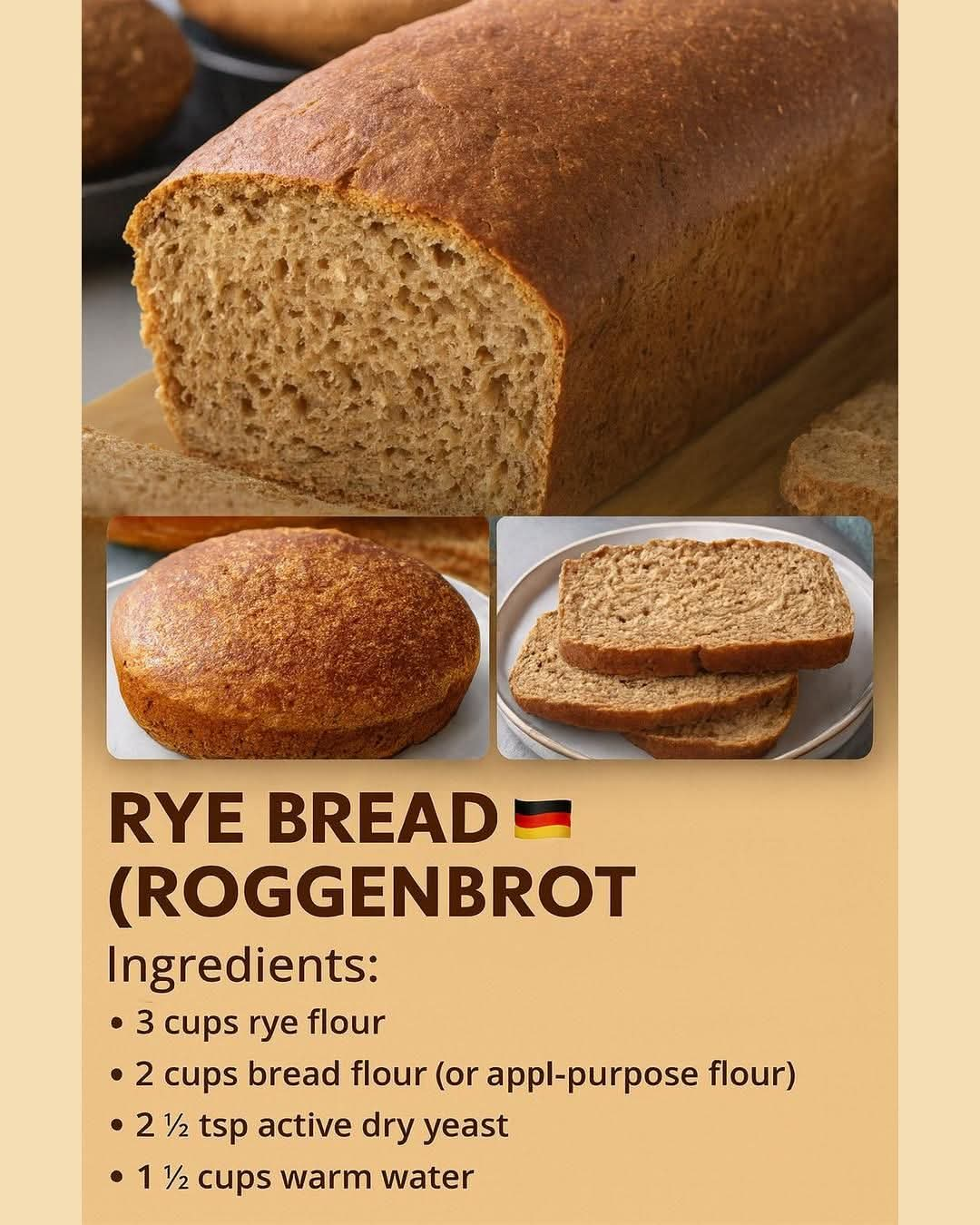Here’s a full, rich recipe write-up for your Rye Bread (Roggenbrot) request — with introduction, history, formation, ingredients, instructions, methods, conclusion, and even a touch of love for the bread lovers.
🌾 Rye Bread (Roggenbrot) – A German Classic
Introduction
Rye Bread, or Roggenbrot, is one of Germany’s most iconic and beloved breads. With its hearty, earthy flavor, dense crumb, and long shelf life, rye bread has been a staple across Europe for centuries. It is often enjoyed with butter, cheese, cured meats, or even just a drizzle of honey. Unlike white bread, which is light and airy, rye bread delivers depth, richness, and a rustic texture that pairs beautifully with both sweet and savory spreads. For bread lovers, baking Roggenbrot at home is more than just a recipe—it’s an act of tradition and love.
A Little History 📖
Rye has been grown in Europe since the Middle Ages, thriving in cold climates where wheat struggled to grow. This made rye the “bread of the people.” In Germany, Roggenbrot became the backbone of daily diets, with countless regional variations—from light rye loaves to dark, sourdough-based breads. Rye flour’s lower gluten content gives it a denser structure, and often sourdough is used for fermentation. Today, rye bread remains a symbol of German culinary culture, found in bakeries across the country and served at almost every meal.
Ingredients 🥖
- 3 cups rye flour
- 2 cups bread flour (or all-purpose flour)
- 2 ½ teaspoons active dry yeast
- 1 ½ cups warm water (about 110°F / 43°C)
- 1 tablespoon honey (or molasses for deeper flavor)
- 2 teaspoons salt
- 1 tablespoon caraway seeds (optional, traditional German touch)
- 1 tablespoon oil or melted butter (for softer crust, optional)
Instructions & Methods 🧑🍳
Step 1 – Activate the Yeast
- In a small bowl, combine warm water, honey, and yeast.
- Let it sit for 5–10 minutes until foamy. This signals the yeast is alive and ready to work.
Step 2 – Make the Dough
- In a large mixing bowl, combine rye flour, bread flour, and salt.
- Add the yeast mixture and stir until a sticky dough forms.
- If desired, mix in caraway seeds for authentic German flavor.
Step 3 – Knead the Dough
- Transfer the dough to a lightly floured surface.
- Knead for 8–10 minutes, adding small sprinkles of flour as needed.
- Note: Rye dough will be stickier and denser than wheat dough—this is normal.
Step 4 – First Rise (Fermentation)
- Place the dough in a greased bowl.
- Cover with a clean towel and let rise in a warm place for 1–1.5 hours, until nearly doubled in size.
Step 5 – Shape the Loaf
- Punch down the dough and form it into a round or oval loaf.
- Place on a parchment-lined baking sheet or in a greased loaf pan.
- Cover and let rise again for about 45 minutes.
Step 6 – Bake
- Preheat your oven to 425°F (220°C).
- Just before baking, slash the top of the loaf with a sharp knife for steam release.
- Bake for 30–35 minutes, until the crust is dark brown and the loaf sounds hollow when tapped on the bottom.
Step 7 – Cool & Serve
- Place on a wire rack and let cool completely before slicing (at least 1 hour).
- Enjoy with butter, cheese, smoked salmon, or even jam for breakfast.
Formation 🍞
The formation of rye bread comes from the balance of rye flour (for flavor and density) and bread flour (for structure and rise). The yeast helps lift the dough, but because rye has less gluten, the crumb remains moist and compact. This gives Roggenbrot its characteristic chewy texture and long-lasting freshness.
Bread Lovers’ Note ❤️
Rye bread isn’t just food—it’s comfort. Lovers of rustic bread find joy in the hearty bite, the nutty aroma, and the satisfaction of a loaf that carries centuries of tradition. Whether you enjoy it warm with butter or paired with a hearty stew, Roggenbrot connects you to generations of bread bakers who treasured the same flavors.
Conclusion 🌟
German Rye Bread (Roggenbrot) is a true testament to the art of traditional baking. With its rustic character, rich flavor, and wholesome texture, this bread represents both history and heart. Bake it once, and you’ll fall in love with its timeless charm. Share it with family and friends, and you’ll discover why rye bread has been cherished by bread lovers for centuries.
Would you like me to also give you a sourdough rye bread (Roggenbrot mit Sauerteig) version? That’s the most traditional German style.
